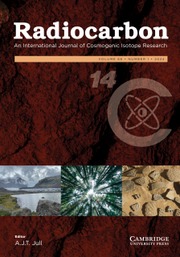Crossref Citations
This article has been cited by the following publications. This list is generated based on data provided by
Crossref.
Straus, Lawrence Guy
1993.
Upper paleolithic origins and radiocarbon calibration: More new evidence from Spain.
Evolutionary Anthropology: Issues, News, and Reviews,
Vol. 2,
Issue. 6,
p.
195.
Collins, L.B
Zhu, Z.R
Wyrwoll, K.-H
Hatcher, B.G
Playford, P.E
Eisenhauer, A
Chen, J.H
Wasserburg, G.J
and
Bonani, G
1993.
Holocene growth history of a reef complex on a cool-water carbonate margin: Easter Group of the Houtman Abrolhos, Eastern Indian Ocean.
Marine Geology,
Vol. 115,
Issue. 1-2,
p.
29.
Stuiver, Minze
and
Braziunas, Thomas F.
1993.
Modeling Atmospheric 14C Influences and 14C Ages of Marine Samples to 10,000 BC.
Radiocarbon,
Vol. 35,
Issue. 1,
p.
137.
Stuiver, Minze
and
Reimer, Paula J.
1993.
Extended 14C Data Base and Revised CALIB 3.0 14C Age Calibration Program.
Radiocarbon,
Vol. 35,
Issue. 1,
p.
215.
Edwards, R. Lawrence
Beck, J. Warren
Burr, G. S.
Donahue, D. J.
Chappell, J. M. A.
Bloom, A. L.
Druffel, E. R. M.
and
Taylor, F. W.
1993.
A Large Drop in Atmospheric
14
C/
12
C and Reduced Melting in the Younger Dryas, Documented with
230
Th Ages of Corals
.
Science,
Vol. 260,
Issue. 5110,
p.
962.
Bond, Gerard
Broecker, Wallace
Johnsen, Sigfus
McManus, Jerry
Labeyrie, Laurent
Jouzel, Jean
and
Bonani, Georges
1993.
Correlations between climate records from North Atlantic sediments and Greenland ice.
Nature,
Vol. 365,
Issue. 6442,
p.
143.
Roberts, Nell
Taieb, Maurice
Barker, Philip
Damnati, Brahlm
Icole, Michel
and
Williamson, David
1993.
Timing of the Younger Dryas event in East Africa from lake-level changes.
Nature,
Vol. 366,
Issue. 6451,
p.
146.
Stuiver, Minze
and
Braziunas, Thomas F.
1993.
Sun, ocean, climate and atmospheric 14CO2 : an evaluation of causal and spectral relationships.
The Holocene,
Vol. 3,
Issue. 4,
p.
289.
Liew, P.M.
Pirazzoli, P.A.
Hsieh, M.L.
Arnold, M.
Barusseau, J.P.
Fontugne, M.
and
Giresse, P.
1993.
Holocene tectonic uplift deduced from elevated shorelines, eastern Coastal Range of Taiwan.
Tectonophysics,
Vol. 222,
Issue. 1,
p.
55.
Imbrie, J.
Berger, A.
Boyle, E. A.
Clemens, S. C.
Duffy, A.
Howard, W. R.
Kukla, G.
Kutzbach, J.
Martinson, D. G.
McIntyre, A.
Mix, A. C.
Molfino, B.
Morley, J. J.
Peterson, L. C.
Pisias, N. G.
Prell, W. L.
Raymo, M. E.
Shackleton, N. J.
and
Toggweiler, J. R.
1993.
On the structure and origin of major glaciation cycles 2. The 100,000‐year cycle.
Paleoceanography,
Vol. 8,
Issue. 6,
p.
699.
STENTOFT, NIELS
1994.
Early submarine cementation in fore‐reef carbonate sediments, Barbados, West Indies.
Sedimentology,
Vol. 41,
Issue. 3,
p.
585.
Hebbeln, Dierk
Dokken, Trond
Andersen, Espen S.
Hald, Morten
and
Elverhøi, Anders
1994.
Moisture supply for northern ice-sheet growth during the Last Glacial Maximum.
Nature,
Vol. 370,
Issue. 6488,
p.
357.
Boulton, Geoffrey S.
and
Payne, Tony
1994.
Long-Term Climatic Variations.
p.
177.
Shennan, Ian
Innes, James B.
Long, Antony J.
and
Zong, Yongqiang
1994.
Late Devensian and Holocene relative sealevel changes at Loch nan Eala, near Arisaig, northwest Scotland.
Journal of Quaternary Science,
Vol. 9,
Issue. 3,
p.
261.
Roberts, Richard G.
Spooner, Nigel A.
and
Questiaux, Danièle G.
1994.
Palaeodose underestimates caused by extended-duration preheats in the optical dating of quartz.
Radiation Measurements,
Vol. 23,
Issue. 2-3,
p.
647.
Rodrigues, Cyril G.
and
Vilks, Gustavs
1994.
The impact of glacial lake runoff on the goldthwait and champlain seas: The relationship between glacial lake agassiz runoff and the younger dryas.
Quaternary Science Reviews,
Vol. 13,
Issue. 9-10,
p.
923.
Bard, Edouard
Arnold, Maurice
Mangerud, Jan
Paterne, Martine
Labeyrie, Laurent
Duprat, Josette
Mélières, Marie-Antoinette
Sønstegaard, Eivind
and
Duplessy, Jean-Claude
1994.
The North Atlantic atmosphere-sea surface 14C gradient during the Younger Dryas climatic event.
Earth and Planetary Science Letters,
Vol. 126,
Issue. 4,
p.
275.
Allen, Jim
1994.
Radiocarbon determinations, luminescence dating and Australian archaeology.
Antiquity,
Vol. 68,
Issue. 259,
p.
339.
Locke, William W.
and
Meyer, Grant A.
1994.
A 12,000‐year record of vertical deformation across the Yellowstone caldera margin: The shorelines of Yellowstone Lake.
Journal of Geophysical Research: Solid Earth,
Vol. 99,
Issue. B10,
p.
20079.
Humlum, Ole
and
Houmark-Nielsen, Michael
1994.
High Deglaciation Rates in Denmark During the Late Weichselian—Implications for the Palaeoenvironment.
Geografisk Tidsskrift-Danish Journal of Geography,
Vol. 94,
Issue. 1,
p.
26.

